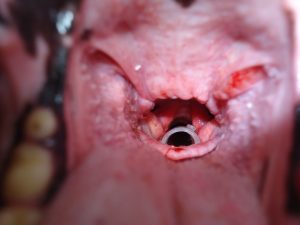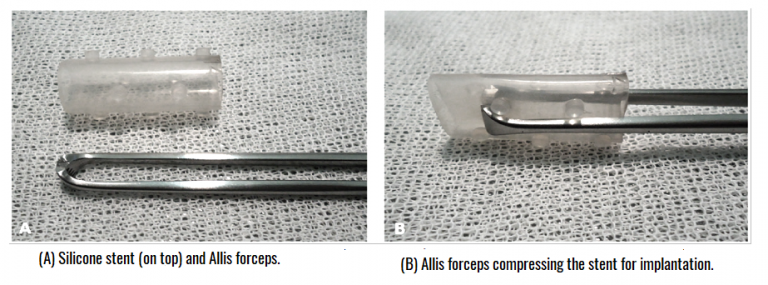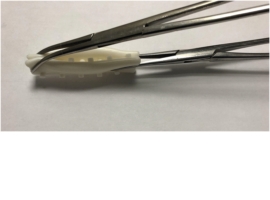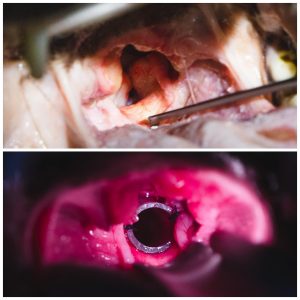FAQ
Why choose a stent?
The placement of this type of laryngeal or tracheal prosthesis is a short, minimally invasive, atraumatic and simple implantation procedure. In many cases it can be a therapeutic alternative to avoid surgery, for example for laryngeal paralysis in elderly dogs to improve their quality of life.
When is it advisable to place a silicone stent?
- laryngeal stenosis
- tracheal collapse
- laryngeal paralysis
- smooth surface tumour
- squamous cell carcinoma
- paroxysmal form of dyspnoea attacks
Why are there so many models of stents?

Because each veterinarian must choose the device that best suits his or her patient’s case.
How do you know the right stent diameter?
The choice of prosthesis diameter would be based on the endotracheal tube that the professional places and we suggest estimating 20% more.
This measure would be based on the choice of the largest endotracheal tube. It is very common to underestimate the diameter of the tube to be used, so it is advisable to have several diameters available at the time of the intervention.
Also, it should be considered that being a minimally invasive procedure makes the prosthesis removable without damage, so if a diameter error is made, it can be easily changed.
A simple way to estimate the approximate diameter is to measure the animal’s muzzle, as shown in the photo:

Can anyone place a stent?
No, it is not possible. Stent insertion needs to be performed by trained personnel and specialists.
What happens when the stent is placed?
Our stents are inserted folded and self-expand when released in the affected area. As they expand, they provide more light, allowing air to circulate inside them. In some cases the practitioner may decide to place a few stitches to secure the stent in place.

View of the laryngeal stent during transoral laryngoscopy, after palatoplasty
How do you determine the size of a stent?
For determining the measure, a bronchoscope or tracheoscope would be fine, and is the common instrument the physicians have in their human interventional facilities. But anything that helps you for comparison is good too.
- For example: a forceps or a catheter.
- The maneuver to determine the length of the stent would be:
6) pick a stent that exceeds that length in about 10mm (5mm before the injury and 5 mm after the injury).
Is fluoroscopy essential for stent insertion?
No, it is not required. Normally, inserting the stent by clamping it with a forceps is sufficient. Each professional has his or her own technique, but in veterinary medicine in particular, stent insertion is much simpler than in humans.

What material is the stent made of?
All our devices are made of medical grade silicone. They can be transparent in case the veterinarian wishes to visualise the tissues through the device, or radiopaque in case he/she wishes to perform radiographic controls.
We are an ISO13485/2016 certified company (medical device manufacturing) and apply the same quality standards to the manufacture of our entire veterinary line.

Lateral neck X-ray: correct position of the laryngeal stent
How often is a stent changed?
It is advisable to do this every three months. But the final decision is at the discretion of each professional and the evolution of the patient.
How is the purchase procedure?
- You must give us all these details in full:
- full name,
- address,
- identity card or passport (or if you are a company, all your company details).
With this information we will proceed to send you the proforma invoice.
- Once you have made the payment by bank transfer or by credit card with Paypal, the device will be sent to you.
- The device is sent by private courier (UPS/DHL) and you will be provided with a tracking number so that you know when the stent will arrive.
- The time we take for dispatch is 24 working hours from the time we have all the shipping and payment information. Then the delivery time depends on each company that provides the service but it is usually from a few days to no more than a week approximately.
Is possible to help a small dog with a tracheal collapse with your stents?
- The stent working principle is really simple and has been used in humans for several decades.
- It is just a tube made of a Medical Grade material (silicone in our case) that makes an inner-outer force that opens a stenosis.
- The matter is to determine the correct size (diameter and length). Another matter in humans is the implant, because physicians have to have the correct instruments.
- This is much quicker, simpler and safer in animals, which, depending on the Vet’s preferences, just one or two forceps are required:

what happens once implanted?
- Once implanted, it is common to see in animals that the Vet makes one or two stitches to fix the device and prevent migration or expulsion by coughing:

- In this last picture you can see that the stent is fixed with two stitches, but also has been cutted by the Vet to adjust length. This can also be done. It is not the perfect scenery but helps in urgencies until you find the correct length device. When cutted, the sharp cutted edges of the devices increase the formation of granulomas, but it is fine to gain some time for having the animal breathing normally until you get the correct size.
Depending on the animal’s health some Vets think that the formation of granulomas it’s a lesser evil because the tissues growing at the ends helps fix the device in its place.
